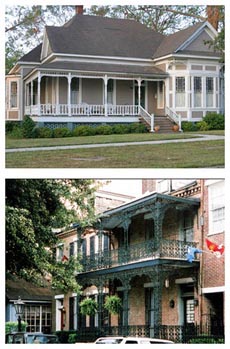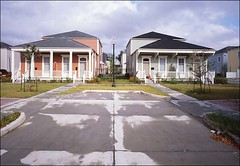Perhaps New Orleans' Cultural Heritage is Doomed
The architect, writer, and educator John Massengale wrote this on the H-Urban email list, comparing the Mississippi Renewal process to that of New Orleans:
New Orleans, on the other hand, is very different. I am not as involved there, but I went to the Louisiana Recovery Conference organized by the AIA [American Institute of Architects], the APA[American Planning Association] and Mayor Nagin's commission, and I am in regular touch with people who are in some of the meetings at the Governor's office and Senator Landrieu's office.
The factionalism mentioned by Kevin Gotham in a different context is in full swing in New Orleans. Specifically on the rebuilding, people who don't know how to make places are being advised by people who have never made good places. The result, I'm afraid, is going to the simultaneous physical neglect and dismemberment of New Orleans outside the French Quarter and the Garden District, which had little flooding (not because they are on the "high ground," but because their levees didn't break -- both areas are well below the level of the Mississippi as it flows by New Orleans).
The Mississippi process is organized and funded. The Louisiana process is lots of factional discussion and unfunded. More than 85% of the population of New Orleans is scattered around the country, but very little is happening to enable them to know when or if they will be able to come back. An important announcement was supposed to be made by the state earlier this week, but local professionals have prevented the announcement thus far.
I am afraid that the Mayor's Commission is proving to be the LMDC (Lower Manhattan Development Corporation) of Louisiana. That is to say, executives operating outside their fields of expertise, being badly advised, and ignoring the public will. Ground Zero was funded and is moving ahead, but it's current state is an ugly fortified tower that no one wants to be in and a proposed shopping mall straight from the sprawl of New Jersey.
 To aid in the rebuilding of Mississippi's Gulf Coast, Rob Robinson of Pittsburgh-based Urban Design Associates created a pattern book of vernacular houses. Shown here are the pyramid, top, and townhouse, above. From "Pittsburgh architects part of team creating designs for devastated Gulf Coast areas."
To aid in the rebuilding of Mississippi's Gulf Coast, Rob Robinson of Pittsburgh-based Urban Design Associates created a pattern book of vernacular houses. Shown here are the pyramid, top, and townhouse, above. From "Pittsburgh architects part of team creating designs for devastated Gulf Coast areas."______
Blair Kamin, the architecture and urban design writer for the Chicago Tribune, has a lot to say about this in his article, "A housing crisis. The cultural stakes could not be higher. New Orleans' extraordinary homes are the essence of this remarkable city. Now, they need help, and they're not getting it from the powers that be." From the article:
Two months after President Bush promised that "this great city will rise again," the risk grows every day that another catastrophe will strike New Orleans -- a catastrophe of ignorance, indifference and missed opportunities to marry rebuilding and the new jobs this impoverished city so desperately needs.
The danger signs are everywhere, from the widespread official support expressed for a new brand of housing that would undermine the city's matchless character to federal foot-dragging on tax measures that would encourage people to rehab New Orleans' extraordinary housing stock. Few in power seem to grasp that the city could use its destruction as a source of regeneration, much as Chicago did after the Great Fire of 1871.
The cultural stakes could not be higher. The homes of New Orleans -- its shotgun houses, Creole cottages, Craftsman bungalows, Southern plantation houses and the lacy, Spanish-style buildings of the French Quarter -- are to this city what skyscrapers are to Chicago: The most visible and visceral expression of the city's essence. Many have been passed down from one generation to another, like treasured heirlooms. No other city has such a high concentration of landmark districts on the National Register of Historic Places....
To be sure, there are some encouraging signs. Last week, for example, a panel of land-use experts representing the Urban Land Institute (ULI), a Washington-based planning organization, wisely suggested that the city's rebuilding occur in phases, starting on the safe high ground. But it is hard not to be skeptical about a new mixed-income housing development here called River Garden and touted by Nagin as a possible model for rebuilding soon-to-be-bulldozed areas. Housing and Urban Development Secretary Alphonso Jackson also has hailed the 60-acre complex.
 River Place, New Orleans. New York Times Photo.
River Place, New Orleans. New York Times Photo.Located in the Lower Garden District near downtown and principally designed by the in-house architects of the developer, Historic Restoration Inc., River Garden seems charming enough at first glance. Instead of stark modern buildings and streets that echo with the sound of gunshots, as there were at the St. Thomas public housing project it replaced, River Garden is almost eerily quiet. Its apartment buildings unabashedly mimic the architectural traditions of New Orleans. There are fanciful Victorian brackets like those on the city's shotgun houses, lacy ironwork as in the French Quarter, and tall white columns that suggest the Lower Garden District's prevailing Greek Revival style. Such flourishes are trademarks of the school of traditional town planning called the New Urbanism.
But while River Garden represents a progressive social model, its architecture and urban design turn out to be like pizza labeled "Chicago-style" -- a weak echo of the real thing.The colors of the apartment buildings are pallid, not vibrant, as in Bywater and other New Orleans' neighborhoods. The details, like the brackets, are larger, cartoonish versions of their turn-of-the-century predecessors. Single-story, shotgun-style fronts are incongruously stuck onto two-story backs that resemble suburban subdivision homes....



0 Comments:
Post a Comment
<< Home